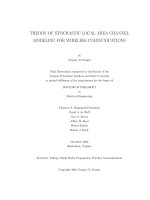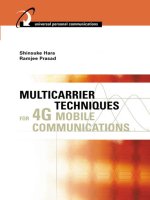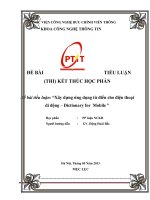Multiple Access Protocols for Mobile Communications - GPRS, UMTS and Beyond
Bạn đang xem bản rút gọn của tài liệu. Xem và tải ngay bản đầy đủ của tài liệu tại đây (2.73 MB, 478 trang )
MULTIPLE ACCESS PROTOCOLS FOR
MOBILE COMMUNICATIONS
Multiple Access Protocols for
Mobile Communications
GPRS, UMTS and Beyond
Alex Brand
Swisscom Mobile, Switzerland
Hamid Aghvami
King’s College London, UK
Copyright
2002 by John Wiley & Sons, Ltd
Baffins Lane, Chichester,
West Sussex, PO19 1UD, England
National 01243 779777
International (+44) 1243 779777
e-mail (for orders and customer service enquiries):
Visit our Home Page on or
All Rights Reserved. No part of this publication may be reproduced, stored in a retrieval system, or
transmitted, in any form or by any means, electronic, mechanical, photocopying, recording, scanning or
otherwise, except under the terms of the Copyright Designs and Patents Act 1988 or under the terms of a
licence issued by the Copyright Licensing Agency, 90 Tottenham Court Road, London, W1P 9HE, UK,
without the permission in writing of the Publisher, with the exception of any material supplied specifically for
the purpose of being entered and executed on a computer system, for exclusive use by the purchaser of the
publication.
Neither the author(s) nor John Wiley & Sons, Ltd accept any responsibility or liability for loss or damage
occasioned to any person or property through using the material, instructions, methods or ideas contained
herein, or acting or refraining from acting as a result of such use. The author(s) and Publisher expressly
disclaim all implied warranties, including merchantability of fitness for any particular purpose.
Designations used by companies to distinguish their products are often claimed as trademarks. In all instances
where John Wiley & Sons, Ltd is aware of a claim, the product names appear in initial capital or capital
letters. Readers, however, should contact the appropriate companies for more complete information regarding
trademarks and registration.
Other Wiley Editorial Offices
John Wiley & Sons, Inc., 605 Third Avenue,
New York, NY 10158-0012, USA
WILEY-VCH Verlag GmbH
Pappelallee 3, D-69469 Weinheim, Germany
John Wiley & Sons Australia Ltd, 33 Park Road, Milton,
Queensland 4064, Australia
John Wiley & Sons (Canada) Ltd, 22 Worcester Road
Rexdale, Ontario, M9W 1L1, Canada
John Wiley & Sons (Asia) Pte Ltd, 2 Clementi Loop #02-01,
Jin Xing Distripark, Singapore 129 809
A catalogue record for this book is available from the British Library
British Library Cataloguing in Publication Data
Brand, Alex
Multiple access protocols for mobile communications: GPRS, UMTS and beyond/
Alex Brand, Hamid Aghvami
p.cm.
Includes bibliographical references and index.
ISBN 0-471-49877-
1. Global system for mobile communications. I. Aghvami, Hamid. II. Title.
TK5103.483 .B73 2001
621.382
12–dc21 2001055758
ISBN 0 471 49877 7
Typeset in 10/12pt Times by Laserwords Private Limited, Madras, India.
Printed and bound in Great Britain by Antony Rowe Ltd, Chippenham, Wiltshire.
This book is printed on acid-free paper responsibly manufactured from sustainable forestry, in which at least
two trees are planted for each one used for paper production.
To M o n i c a
CONTENTS
Preface xv
Acknowledgements xix
Abbreviations xxi
Symbols xxxi
1 Introduction 1
1.1 An Introduction to Cellular Communication Systems 1
1.1.1 The Cellular Concept 1
1.1.2 Propagation Phenomena in Cellular Communications 2
1.1.3 Basic Multiple Access Schemes 3
1.1.4 Cell Clusters, Reuse Factor and Reuse Efficiency 6
1.1.5 Types of Interference and Noise Affecting Communications 6
1.2 The Emergence of the Internet and its Impact on Cellular
Communications 8
1.3 The Importance of Multiple Access Protocols in Cellular
Communications 10
1.4 A PRMA-based Protocol for Hybrid CDMA/TDMA 12
1.4.1 Why Combine CDMA and PRMA? 12
1.4.2 Hybrid CDMA/TDMA Multiple Access Schemes 14
1.4.3 Literature on Multiple Access Protocols for Packet CDMA 15
1.4.4 Access Control in Combined CDMA/PRMA Protocols 15
1.4.5 Summary 21
2 Cellular Mobile Communication Systems: From 1G to 4G 23
2.1 Advantages and Limitations of the Cellular Concept 23
2.2 1G and 2G Cellular Communication Systems 25
2.2.1 Analogue First Generation Cellular Systems 25
2.2.2 Digital Second Generation Systems 25
2.3 First 3G Systems 27
2.3.1 Requirements for 3G 27
2.3.2 Evolution of 2G Systems towards 3G 29
2.3.3 Worldwide 3G Standardisation Efforts 31
2.3.4 The Third Generation Partnership Project (3GPP) 32
2.3.5 The Universal Mobile Telecommunications System (UMTS) 33
2.3.6 The Spectrum Situation for UMTS 35
2.3.7 UTRA Modes vs UTRA Requirements 36
viii
CONTENTS
2.3.8 3GPP2 and cdma2000 38
2.4 Further Evolution of 3G 40
2.4.1 Support of IP Multimedia Services through EGPRS and
UMTS 40
2.4.2 Improvements to cdma2000 1×RTT, UTRA FDD and TDD 41
2.4.3 Additional UTRA Modes 42
2.5 And 4G? 44
2.5.1 From 1G to 3G 44
2.5.2 Possible 4G Scenarios 44
2.5.3 Wireless Local Area Network (WLAN) Standards 46
2.6 Summary 48
3 Multiple Access in Cellular Communication Systems 49
3.1 Multiple Access and the OSI Layers 49
3.2 Basic Multiple Access Schemes 53
3.3 Medium Access Control in 2G Cellular Systems 57
3.3.1 Why Medium Access Control is Required 57
3.3.2 Medium Access Control in GSM 58
3.4 MAC Strategies for 2.5G Systems and Beyond 59
3.4.1 On the Importance of Multiple Access Protocols 59
3.4.2 Medium Access Control in CDMA 60
3.4.3 Conflict-free or Contention-based Access? 62
3.5 Review of Contention-based Multiple Access Protocols 63
3.5.1 Random Access Protocols: ALOHA and S-ALOHA 64
3.5.2 Increasing the Throughput with Splitting or Collision
Resolution Algorithms 68
3.5.3 Resource Auction Multiple Access 69
3.5.4 Impact of Capture on Random Access Protocols 70
3.5.5 Random Access with CDMA 72
3.5.6 Protocols based on some Form of Channel Sensing 72
3.5.7 Channel Sensing with CDMA 74
3.5.8 A Case for Reservation ALOHA-based Protocols 75
3.6 Packet Reservation Multiple Access: An R-ALOHA Protocol
Supporting Real-time Traffic 76
3.6.1 PRMA for Microcellular Communication Systems 76
3.6.2 Description of ‘Pure’ PRMA 77
3.6.3 Shortcomings of PRMA 79
3.6.4 Proposed Modifications and Extensions to PRMA 81
3.6.5 PRMA for Hybrid CDMA/TDMA 84
3.7 MAC Requirements vs R-ALOHA Design Options 86
3.7.1 3G Requirements Relevant for the MAC Layer 86
3.7.2 Quality of Service Requirements and the MAC Layer 89
3.7.3 A few R-ALOHA Design Options 92
3.7.4 Suitable R-ALOHA Design Choices 94
3.8 Summary and Scope of Further Investigations 96
4 Multiple Access in GSM and (E)GPRS 99
4.1 Introduction 99
4.1.1 The GSM System 99
CONTENTS
ix
4.1.2 GSM Phases and Releases 101
4.1.3 Scope of this Chapter 104
4.1.4 Approach to the Description of the GSM Air Interface 105
4.2 Physical Channels in GSM 106
4.2.1 GSM Carriers, Frequency Bands, and Modulation 107
4.2.2 TDMA, the Basic Multiple Access Scheme — Frames,
Time-slots and Bursts 108
4.2.3 Slow Frequency Hopping and Interleaving 111
4.2.4 Frame Structures: Hyperframe, Superframe and
Multiframes 115
4.2.5 Parameters describing the Physical Channel 115
4.3 Mapping of Logical Channels onto Physical Channels 115
4.3.1 Traffic Channels 115
4.3.2 Signalling and Control Channels 116
4.3.3 Mapping of TCH and SACCH onto the 26-Multiframe 120
4.3.4 Coding, Interleaving, and DTX for Voice on the TCH/F 120
4.3.5 Coding and Interleaving on the SACCH 124
4.3.6 The Broadcast Channel and the 51-Multiframe 124
4.4 The GSM RACH based on Slotted ALOHA 126
4.4.1 Purpose of the RACH 126
4.4.2 RACH Resources in GSM 127
4.4.3 The Channel Request Message 127
4.4.4 The RACH Algorithm 128
4.4.5 Contention Resolution in GSM 131
4.4.6 RACH Efficiency and Load Considerations 132
4.5 HSCSD and ECSD 134
4.5.1 How to Increase Data-rates 134
4.5.2 Basic Principles of HSCSD 135
4.5.3 Handover in HSCSD 136
4.5.4 HSCSD Multi-slot Configurations and MS Classes 137
4.5.5 Enhanced Circuit-Switched Data (ECSD) 139
4.6 Resource Utilisation and Frequency Reuse 140
4.6.1 When are Resources Used and for What? 140
4.6.2 How to Assess Resource Utilisation 143
4.6.3 Some Theoretical Considerations —
The Erlang B Formula 144
4.6.4 Resource Utilisation in Blocking-limited GSM 145
4.6.5 Resource Utilisation in Interference-limited GSM 152
4.7 Introduction to GPRS 155
4.7.1 The Purpose of GPRS: Support of Non-real-time
Packet-data Services 155
4.7.2 Air-Interface Proposals for GPRS 157
4.7.3 Basic GPRS Principles 158
4.7.4 GPRS System Architecture 160
4.7.5 GPRS Protocol Stacks 161
4.7.6 MS Classes 163
4.7.7 Mobility Management and Session Management 163
x
CONTENTS
4.8 GPRS Physical and Logical Channels 164
4.8.1 The GPRS Logical Channels 164
4.8.2 Mapping of Logical Channels onto Physical Channels 165
4.8.3 Radio Resource Operating Modes 168
4.8.4 The Half-Rate PDCH and Dual Transfer Mode 169
4.9 The GPRS Physical Layer 170
4.9.1 Services offered and Functions performed by the Physical
Link Layer 171
4.9.2 The Radio Block Structure 171
4.9.3 Channel Coding Schemes 171
4.9.4 Theoretical GPRS Data-Rates 172
4.9.5 ‘Real’ GPRS Data-rates and Link Adaptation 175
4.9.6 The Timing Advance Procedure 177
4.9.7 Cell Reselection 179
4.9.8 Power Control 179
4.10 The GPRS RLC/MAC 180
4.10.1 Services offered and Functions performed by MAC and RLC 180
4.10.2 The RLC Sub-layer 181
4.10.3 Basic Features of the GPRS MAC 181
4.10.4 Multiplexing Principles 183
4.10.5 RLC/MAC Block Structure 184
4.10.6 RLC/MAC Control Messages 185
4.10.7 Mobile Originated Packet Transfer 188
4.10.8 Mobile Terminated Packet Transfer 194
4.11 The GPRS Random Access Algorithm 197
4.11.1 Why a New Random Access Scheme for GPRS? 197
4.11.2 Stabilisation of the Random Access Algorithm 198
4.11.3 Prioritisation at the Random Access 206
4.11.4 The GPRS Random Access Algorithm 207
4.12 EGPRS 211
4.12.1 EGPRS Coding Schemes and Link Quality Control 212
4.12.2 Other EGPRS Additions and Issues 216
4.12.3 EDGE Compact 218
4.12.4 Further Evolution of GPRS 220
5 Models for the Physical Layer and for User Traffic Generation 221
5.1 How to Account for the Physical Layer? 221
5.1.1 What to Account For and How? 221
5.1.2 Using Approximations for Error Performance Assessment 222
5.1.3 Modelling the UTRA TD/CDMA Physical Layer 223
5.1.4 On Capture and Required Accuracy of Physical Layer
Modelling 225
5.2 Accounting for MAI Generated by Random Codes 225
5.2.1 On Gaussian Approximations for Error Performance
Assessment 225
5.2.2 The Standard Gaussian Approximation 227
5.2.3 Deriving Packet Success Probabilities 228
5.2.4 Importance of FEC Coding in CDMA 229
CONTENTS
xi
5.2.5 Accounting for Intercell Interference 231
5.2.6 Impact of Power Control Errors 236
5.3 Perfect-collision Code-time-slot Model for TD/CDMA 237
5.3.1 TD/CDMA as a Mode for the UMTS Terrestrial Radio
Access 237
5.3.2 The TD/CDMA Physical Layer Design Parameters 238
5.3.3 In-Slot Protocols on TD/CDMA 240
5.4 Accounting for both Code-collisions and MAI 241
5.5 The Voice Traffic Model 242
5.5.1 Choice of Model 242
5.5.2 Description of the Chosen Source Model 244
5.5.3 Model of Aggregate Voice Traffic 245
5.6 Traffic Models for NRT Data 246
5.6.1 Data Terminals 246
5.6.2 The UMTS Web Browsing Model 247
5.6.3 Proposed Email Model 250
5.6.4 A Word on Traffic Asymmetry 252
5.6.5 Random Data Traffic 253
5.7 Some Considerations on Video Traffic Models 253
5.8 Summary and some Notes on Terminology 255
6 Multidimensional PRMA 257
6.1 A Word on Terminology 257
6.2 Description of MD PRMA 258
6.2.1 Some Fundamental Considerations and Assumptions 258
6.2.2 The Channel Structure Considered 258
6.2.3 Contention and Packet Dropping 259
6.2.4 Accounting for Coding and Interleaving 261
6.2.5 Duration of a Reservation Phase 261
6.2.6 Downlink Signalling of Access Parameters and
Acknowledgements 262
6.2.7 Resource Allocation Strategies for Different Services 263
6.2.8 Performance Measures for MD PRMA 263
6.3 MD PRMA with Time-Division Duplexing 264
6.3.1 Approaches to Time-Division Duplexing 264
6.3.2 TDD with Alternating Uplink and Downlink Slots 266
6.3.3 MD FRMA for TDD with a Single Switching-Point per
Frame 266
6.4 Load-based Access Control 267
6.4.1 The Concept of Channel Access Functions 267
6.4.2 Downlink Signalling with Load-based Access Control 269
6.4.3 Load-based Access Control in MD PRMA vs Channel Load
Sensing Protocol for Spread Slotted ALOHA 269
6.5 Backlog-based Access Control 270
6.5.1 Stabilisation of Slotted ALOHA with Ternary Feedback 270
6.5.2 Pseudo-Bayesian Broadcast for Slotted ALOHA 270
6.5.3 Bayesian Broadcast for Two-Carrier Slotted ALOHA 271
xii
CONTENTS
6.5.4 Bayesian Broadcast for MD PRMA with Orthogonal
Code-Slots 272
6.5.5 Accounting for Acknowledgement Delays 273
6.5.6 Bayesian Broadcast for MD FRMA 274
6.5.7 Estimation of the Arrival Rate 274
6.5.8 Impact of MAI on Backlog Estimation 275
6.6 Combining Load- and Backlog-based Access Control 276
6.7 Summary 276
7 MD PRMA with Load-based Access Control 279
7.1 System Definition and Choice of Design Parameters 279
7.1.1 System Definition and Simulation Approach 279
7.1.2 Choice of Design Parameters 280
7.2 The Random Access Protocol as a Benchmark 281
7.2.1 Description of the Random Access Protocol 281
7.2.2 Analysis of the Random Access Protocol 282
7.2.3 Analysis vs Simulation Results 283
7.2.4 On Multiplexing Efficiency with RAP 284
7.3 Three More Benchmarks 288
7.3.1 The Minimum-Variance Benchmark 288
7.3.2 The ‘Circuit-Switching’ Benchmark 291
7.3.3 Access Control based on Known Backlog 291
7.4 Choosing Channel Access Functions 293
7.4.1 The Heuristic Approach 293
7.4.2 Semi-empirical Channel Access Functions 293
7.5 On the Benefit of Channel Access Control 298
7.5.1 Simulation Results vs Benchmarks 298
7.5.2 Benefits of Fast Voice Activity Detection 301
7.5.3 Interpretation of the Results and the
‘Soft Capacity’ Issue 302
7.6 Impact of Power Control Errors and the Spreading Factor on
Multiplexing Efficiency 303
7.6.1 Impact of Power Control Errors on Access Control 303
7.6.2 A Theoretical Study on the Impact of Power Control Errors
and the Spreading Factor 305
7.6.3 ‘Power Grouping’: Another Way to Combat Power Control
Errors? 308
7.7 Summary 308
8 MD PRMA on Code-Time-Slots 311
8.1 System Definition and Simulation Approach 311
8.1.1 System Definition and Choice of Design Parameters 311
8.1.2 Simulation Approach, Traffic Parameters and Performance
Measures 313
8.1.3 Analysis of MD PRMA 313
8.2 Comparison of PRMA, MD PRMA and RCMA Performances 314
8.2.1 Simulation Results, No Interleaving 314
8.2.2 Performance Comparison and Impact of Interleaving 316
CONTENTS
xiii
8.3 Detailed Assessment of MD PRMA and MD FRMA Performances 317
8.3.1 Impact of Acknowledgement Delays on MD PRMA
Performance 317
8.3.2 MD FRMA vs MD PRMA 320
8.3.3 Performance of MD FRMA in TDD Mode 321
8.3.4 Impact of Voice Model Parameters on MD PRMA
Performance 322
8.4 Combining Backlog-based and Load-based Access Control 323
8.4.1 Accounting for Multiple Access Interference 323
8.4.2 Performance of Combined Load- and Backlog-based Access
Control 325
8.5 Summary 326
9 MD PRMA with Prioritised Bayesian Broadcast 329
9.1 Prioritisation at the Random Access Stage 329
9.2 Prioritised Bayesian Broadcast 331
9.2.1 Bayesian Scheme with Two Priority Classes and
Proportional Priority Distribution 331
9.2.2 Bayesian Scheme with Two Priority Classes and
Non-proportional Priority Distribution 332
9.2.3 Bayesian Scheme with Four Priority Classes and
Semi-proportional Priority Distribution 332
9.2.4 Bayesian Scheme with Four Priority Classes and
Non-proportional Priority Distribution 333
9.2.5 Priority-class-specific Backlog Estimation 334
9.2.6 Algorithms for Frame-based Protocols 335
9.3 System Definition and Simulation Approach 336
9.3.1 System Definition 336
9.3.2 Simulation Approach 337
9.3.3 Traffic Scenarios Considered 338
9.4 Simulation Results for Mixed Voice and Web Traffic 339
9.4.1 Voice and a Single Class of Web Traffic 339
9.4.2 Voice and Two Classes of Web Traffic 340
9.5 Simulation Results for Mixed Voice and Email Traffic 341
9.5.1 Performance with Unlimited Allocation Cycle Length 341
9.5.2 Impact of Limiting Allocation Cycle Lengths 342
9.6 Simulation Results for Mixed Voice, Web and Email Traffic 344
9.6.1 Equal Share of Data Traffic per Priority Class 344
9.6.2 Unequal Share of Data Traffic per Priority class 344
9.7 Summary 347
10 Packet Access in UTRA FDD and UTRA TDD 349
10.1 UTRAN and Radio Interface Protocol Architecture 349
10.1.1 UTRAN Architecture 349
10.1.2 Radio Interface Protocol Architecture 350
10.1.3 3GPP Document Structure for UTRAN 352
10.1.4 Physical Layer Basics 352
10.1.5 MAC Layer Basics 356
10.1.6 RLC Layer Basics 357
xiv
CONTENTS
10.2 UTRA FDD Channels and Procedures 358
10.2.1 Mapping between Logical Channels and Transport Channels 358
10.2.2 Physical Channels in UTRA FDD 358
10.2.3 Mapping of Transport Channels and Indicators to Physical
Channels 362
10.2.4 Power Control 363
10.2.5 Soft Handover 364
10.2.6 Slotted or Compressed Mode 365
10.3 Packet Access in UTRA FDD Release 99 365
10.3.1 RACH Procedure and Packet Data on the RACH 366
10.3.2 The Common Packet Channel 370
10.3.3 Packet Data on Dedicated Channels 374
10.3.4 Packet Data on the Downlink Shared Channel 377
10.3.5 Time-Division Multiplexing vs Code-Division Multiplexing 378
10.4 Packet Access in UTRA TDD 380
10.4.1 Mapping between Logical and Transport Channels 380
10.4.2 Frame Structure and Physical Channels in UTRA TDD 381
10.4.3 Random Access Matters in UTRA TDD 382
10.4.4 Packet Data on Dedicated Channels 384
10.4.5 Packet Data on Shared Channels 384
10.5 High-Speed Packet Access 386
10.5.1 Adaptive Modulation and Coding, Hybrid ARQ 386
10.5.2 Fast Cell Selection 388
10.5.3 MIMO Processing 388
10.5.4 Stand-alone DSCH 388
10.5.5 And What About Increased Data-rates on the Uplink? 389
11 Towards ‘All IP’ and Some Concluding Remarks 391
11.1 Towards ‘All IP’: UMTS and GPRS/GERAN Release 5 391
11.2 Challenges of Voice over IP over Radio 394
11.2.1 Payload Optimisation 395
11.2.2 VoIP Header Overhead 396
11.2.3 How to Reduce the Header Overhead 396
11.3 Real-time IP Bearers in GERAN 399
11.3.1 Adoption of UMTS Protocol Stacks for GERAN 399
11.3.2 Shared or Dedicated Channels? 399
11.3.3 Proposals for Shared Channels 401
11.3.4 Likely GERAN Solutions 402
11.4 Summarising Comments on Multiplexing Efficiency and Access
Control 403
11.4.1 TDMA Air Interfaces 404
11.4.2 Hybrid CDMA/TDMA Interfaces 405
11.4.3 CDMA Air Interfaces 407
Bibliography 409
Appendix 427
PREFACE
Hamid Ahgvami, the director of the Centre for Telecommunications Research at King’s
College London, who supervised numerous research projects on third generation (3G)
mobile communication systems at his centre, was intrigued by both code-division multiple
access (CDMA) and packet reservation multiple access (PRMA). In the early 1990s, these
were two prime multiple access candidates for 3G systems, the latter essentially enhancing
an air interface using time-division multiple access (TDMA) as a basic multiple access
scheme. When Alex Brand arrived at King’s in 1994 as an exchange student to carry out
a project in conclusion of his studies at the Swiss Federal Institute of Technology (ETH)
in Zurich, his brief was simple: try to combine CDMA and PRMA.
What started as a five-month research project resulted in several publications, a Ph.D.
thesis, and quite a few follow-on publications by other researchers on the subject of
combined CDMA/PRMA protocols, both at King’s and elsewhere. In the following, we
refer to these protocols as so-called multidimensional PRMA (MD PRMA) protocols, an
umbrella term, which accommodates also ‘non-CDMA environments’. Nevertheless, we
are mostly looking at ‘CDMA environments’.
The Ph.D. thesis, while naturally focussing on specific research contributions related
to PRMA-based protocols, embedded these results in a quite thorough discussion of
multiple access protocols for mobile cellular communications in general, which are the
main topic of this book. Accordingly, its starting point was the Ph.D. thesis. It was then
substantially expanded to cover multiple access in GSM/GPRS and in UMTS, as well
as latest trends in the industry towards the merging of wireless communications and IP-
based data communications, including their impact on multiple access strategies for mobile
communications. Indeed, in tune with the increasing importance of IP technologies, the
main focus of this book is on the support of packet-voice and packet-data traffic on the air
interface. Topics of particular interest in this context include matters related to resource
utilisation and multiplexing efficiency and probabilistic access control used for access
arbitration at the medium access control (MAC) layer.
From an OSI layering perspective, the generic term ‘multiple access’ spans often both
layer 1, the physical layer, and the lower sub-layer of layer 2, the MAC (sub-)layer. We
associate ‘basic multiple access schemes’ with the physical layer, and ‘multiple access
protocols’ with the MAC (sub-)layer. Unlike the few books dealing exclusively with
multiple access protocols, a key concern for the present book is the wider framework (of
mobile communications) in which they have to operate. Apart from issues associated with
the physical layer and with layers above the MAC sub-layer, this includes also general
design principles and constraints of mobile communication systems, which have an impact
on these protocols.
xvi
PREFACE
In its present shape, this book hopes to provide a good balance between specific research
results, some disseminated already by the authors in scientific journals and conference
proceedings, others published here for the first time, and useful considerations on mobile
communications from 2G to evolved 3G systems. The latter includes a discussion of the
evolutionary path of the dominant 2G standard, GSM, first to a 2.5G system (mainly
through the addition of GPRS), then to the first release of a ‘full’ 3G system in the shape
of UMTS, and finally to subsequent releases adopting more and more IP-based technolo-
gies. Possible 4G scenarios are also discussed. This book is therefore a valuable source of
information for anybody interested in the latest trends in mobile communications, which
is accessible in Chapters 1 to 4, 10 and 11 without having to delve into lots of maths.
Chapters 5 to 9 are more geared towards researchers and designers of multiple access
protocols and other aspects of air interfaces for mobile communication systems. Accord-
ingly, some of these chapters feature a few mathematical formulas, mostly in the area of
probability theory.
Chapter 1 introduces first the main concepts related to mobile cellular communication
systems. It then discusses the importance of multiple access protocols and the impact
of the emergence of the Internet on cellular communications. Finally, it summarises the
specific research contributions of the authors documented in detail in further chapters.
They are mainly related to access control in the context of the multiple access protocols
investigated.
Expanding on this introductory chapter, Chapter 2 provides more insight into current
and future cellular communication systems from 1G to 4G. In particular, it discusses
initial requirements on which the design of 3G systems was based, how 2G systems can
be evolved to meet 3G requirements, and what drives the further evolution of 3G towards
4G systems. The latter includes a possible convergence between cellular communications,
the Internet and the broadcast world. The role which wireless local area networks (WLAN)
are expected to play in such scenarios is also reviewed.
In Chapter 3, MAC strategies for cellular communication systems, which help meet
the requirements for 3G and beyond, are examined in the context of the general problem
of multiple access in cellular communications. A considerable effort is invested in juxta-
posing PRMA-based strategies with possible alternatives, assessing the respective advan-
tages and disadvantages qualitatively and/or quantitatively.
Chapter 4 traces the evolution of the GSM air interface standards from the first system
release through to release 1999 of the standards, that is from a system designed primarily
for voice to one which offers sophisticated support for packet data through an enhanced
version of GPRS. The air interface spans roughly the first three OSI layers. Naturally,
our main interest lies at the MAC layer, but its description is embedded into an in-depth
discussion of physical and logical channels defined for GSM. In fact, for ‘plain GSM’, the
MAC layer is a relatively minor matter anyway, of certain limited relevance for issues
such as radio resource utilisation, another topic of interest on which we also present
some research results. From a MAC perspective, GPRS is much more interesting and
thus featured more prominently than ‘plain GSM’. The GPRS MAC layer, in particular
the random access protocol, is explained in considerable detail. The description of the
latter is complemented by research results we fed into the GPRS standardisation process.
The release 1999 additions which are discussed include incremental redundancy and the
so-called EDGE COMPACT mode.
PREFACE
xvii
To investigate the performance of multiple access protocols, it is necessary to model
somehow the physical layer, on the services of which the MAC layer depends. In addition,
one has to be aware of what services higher layers expect from the MAC layer. For our
research on PRMA-based protocols, as far as higher layers are concerned, the main focus
is on the traffic generated, which will be handed down to the MAC layer and which it has
to transfer making best possible use of the available physical link. Appropriate models for
physical layer performance assessment and traffic generation are discussed in Chapter 5.
Chapter 6 will define MD PRMA in detail, and introduce the two fundamental approa-
ches considered to probabilistic access control at the MAC, namely load-based and
backlog-based access control. As mentioned previously, access control is one of the
research topics to which we devote particular attention.
In Chapter 7, results of investigations on the benefit of load-based access control in MD
PRMA are reported. To this end, for voice-only traffic, the performance of MD PRMA
in the presence of intracell and intercell interference is compared with that of a random
access protocol and with various benchmarks. The impact of power control errors is also
discussed.
In Chapter 8, backlog-based access control for MD PRMA is treated in detail and
an assessment of its advantages compared to fixed permission probabilities is provided.
This includes a comparison of the multiplexing efficiencies achieved in TDMA-only,
hybrid CDMA/TDMA, and CDMA-only environments. The impact of acknowledgement
delays and a protocol mode for time-division duplex are discussed. The combination of
backlog-based and load-based access control is studied. Again, only packet-voice traffic
is considered.
Chapter 9 provides a discussion of approaches to prioritisation at the random access.
It then presents simulation results for the chosen prioritised pseudo-Bayesian algorithm,
tested in a mixed traffic environment consisting of voice, Web browsing, and email traffic.
In Chapter 10, after having introduced basic concepts of the UMTS air interface and the
radio access network architecture, UTRA FDD channels and procedures are reviewed. The
main effort is invested in exploring how packet-data traffic can be supported on UTRA
FDD according to release 1999 of the standards. Packet access in UTRA TDD is also
reviewed. Further, we discuss to what extent some of the research results on access control
documented in the previous chapters can be applied to UTRA FDD and UTRA TDD.
Finally, the nature of possible enhancements beyond release 1999 providing high-speed
packet access is explained.
Chapter 11 concludes the main body of this book. It introduces architectural enhance-
ments to the UMTS packet-switched core network for the support of real-time IP-based
traffic, the new IP multimedia subsystem, and enhancements to the GPRS/EDGE radio
access network which allow the latter to be connected to the UMTS core network. These
endeavours can be viewed as an important step towards ‘all-IP’. Challenges relating to
the support of real-time IP services over cellular air interfaces are discussed and possible
solutions are outlined on how to overcome problems such as the spectral inefficiency
associated with standard voice over IP over radio. Enhancements to the GPRS/EDGE
air interface, enabling it to support real-time packet-data services, are reviewed. The last
section provides summarising comments on multiplexing efficiency and access control,
two key topics dealt with extensively throughout this book.
Each chapter is preceded by a short outline of the topics to be treated. Chapters are
divided into a number of sections (e.g. Section 4.2), which may in turn be split into
xviii
PREFACE
several subsections (such as Subsection 4.2.3). With two exceptions, chapters close with
a summary and some intermediate conclusions. Readers may find the list of abbreviations
useful, and also another list containing the symbols used throughout this book. They can
be found after the acknowledgements following this preface. Care was taken to choose the
symbols in a manner so that ambiguities are avoided. At times, this required the choice of
symbols other than those used in previous publications, possibly untypical ones, such as X
for the spreading factor instead of the widely used N, because N is also commonly used
to denote the number of time slots per TDMA frame. As far as acronyms are concerned,
we made an effort to write them out in full whenever they occurred first in each chapter,
but exceptions include regularly recurring acronyms and cases where they are used in
passing first, and explicitly introduced soon after. Finally, following a list of references,
an appendix provides some useful information on GSM and UMTS standard documents.
ACKNOWLEDGEMENTS
The authors would like to thank the many people at King’s College London and elsewhere
who either acted in a supporting role, for instance by maintaining the necessary computer
infrastructure, or contributed directly to the research efforts documented in this book. The
latter include Celia Fresco Diez, David Sanchez, Francois Honore and Jean-Christoph
Sindt, all M.Sc. or exchange students involved in research projects relating to topics
treated in this book. H. C. Perle and Bruno Rechberger, at the time with the Swiss Federal
Institute, Zurich, provided useful input to the early stages of our research efforts, as
mentioned in the text. Special thanks go to John Pearson, who reviewed all of our earlier
joint publications and Alex Brand’s Ph.D. thesis; in part these documents are incorporated
in this book. We would also like to express our gratitude to Dr Mark Searle and Prof.
Lajos Hanzo for the useful input provided, and to our industrial partners in the LINK
ACS research project, NEC, Plextek and Vodafone, for the many stimulating discussions.
It was thanks to the involvement in this project that Alex Brand could attend SMG2 GPRS
standardisation meetings from 1995 to 1997 as an academic. A special mention goes to
John Wiley & Sons, Ltd, particularly for the considerable flexibility shown regarding the
submission deadline for this book.
Alex Brand would like to thank his parents for all the support provided, not the least
for having wired their house throughout, providing an excellent computing infrastructure
which, while visiting them in Switzerland, accelerated the completion of the book, and the
parents in Italy for the continuous moral support provided. He would also like to mention
his colleagues at BT Wireless, for instance Fred Harrison, Steve Hearnden, Kevin Holley
and Steve Mecrow, with whom he had many useful discussions on topics related to this
book. Discussions held with Richard Townend proved particularly valuable. Apart from
providing some key input to Chapter 10, they have helped by shifting away from the
sometimes misleading notion of ‘packet-switching vs circuit-switching over the air’, and
instead focus on dedicated vs common or shared channels.
One person has to be singled out, Monica Dell’Anna, Alex Brand’s wife. Among her
many roles, she was an invaluable technical consultant, mainly on physical layer issues,
a guinea pig as a reader of the text, judging it both in terms of content and presentation,
and she acted as an illustrator. She also helped with some of the more tedious jobs, such
as text formatting, and besides all this, she ran the household with little support from her
husband. Simply put, this book would not have been possible without her. Words cannot
express enough gratitude.
ABBREVIATIONS
16QAM 16-Quadrature Amplitude Modulation
2BB-LQC Two-Burst-Based Link Quality Control (EGPRS)
3G Third Generation Cellular Communication Systems (also: 1G, 2G, 4G)
3GPP Third Generation Partnership Project
64QAM 64-Quadrature Amplitude Modulation
8PSK 8-Phase Shift Keying
A
A-Slot Acknowledgement Slot
AB Access Burst
ACCH Access Control CHannel (proposed UTRA channel)
Associated Control CHannel (GSM)
ACI Adjacent Channel Interference
ACK (Positive) Acknowledgement
ACTS Advanced Communications Technologies and Services
AGCH Access Grant CHannel (GSM)
AI Access Indicator (UTRA FDD indicator)
AICH Access Indicator CHannel (UTRA FDD physical channel)
AIUR Air-Interface User-Rate
AMC Adaptive Modulation and Coding
AMPS Advanced Mobile Phone System
AMR Adaptive Multi-Rate Voice Codec
AN Access Network
AP-AICH CPCH Access Preamble Acquisition Indicator CHannel (UTRA FDD
physical channel)
API Access Preamble acquisition Indicator (UTRA FDD indicator)
APN Access Point Name (GPRS)
ARIB Association of Radio Industries and Businesses
ARQ Automatic Repeat reQuest
ASC Access Service Class (UMTS)
ASCI Advanced Speech Call Item(s)
ATM Asynchronous Transfer Mode
ATDMA Advanced TDMA
AUC Authentication Centre
AWGN Additive White Gaussian Noise
xxii
ABBREVIATIONS
B
BB Bayesian Broadcast
BCCH Broadcast Control CHannel (GSM, UTRA logical channel)
BCH Bose–Chaudhuri–Hocquenghem (Codes), or
Broadcast CHannel (UTRA transport channel)
BCS Block Check Sequence (GPRS)
BER Bit Error Rate
BLER Block Error Rate (for GPRS)
BMC Broadcast/Multicast Control (UMTS)
BRMA Burst Reservation Multiple Access
BPSK Binary Phase Shift Keying
BRAN Broadband Radio Access Network
BS Base Station
BSC Base Station Controller
BSIC Base Station Identity Code
BSN Block Sequence Number
BSS Base Station System
BSSGP BSS GPRS Protocol
BTS Base Transceiver Station
C
C-Plane Control Plane
C-PRMA Centralised PRMA
C-Slot Contention Slot
CA Cell Allocation (of radio frequency channels) in GSM
Channel Assignment in UMTS (for CPCH operation)
CAF Channel Access Function
CBCH Cell Broadcast Channel (GSM)
CBR Constant Bit-Rate
CCCH Common Control CHannel (GSM, UTRA logical channel)
CCPCH Common Control Physical CHannel (UTRA physical channel)
CCTrCH Coded Composite Transport CHannel (UTRA)
CD Collision Detection
CD/CA-ICH CPCH Collision Detection/Channel Assignment Indicator CHannel
(UTRA FDD physical channel)
CDI Collision Detection Indicator (UTRA FDD indicator)
CDI/CAI Collision Detection Indicator / Channel Assignment Indicator (UTRA
FDD indicator)
CDM Code-Division Multiplexing
CDMA Code-Division Multiple Access
CDPA Capture-Division Packetised Access
CEPT Conf
´
erence Europ
´
eenne des Administrations des Postes et des
T
´
el
´
ecommunications (European Conference of Postal and
Telecommunications Administrations)
CFCCH COMPACT Frequency Correction CHannel
CIR Carrier-to-Interference Ratio
ABBREVIATIONS
xxiii
CLSP Channel Load Sensing Protocol
CLT Central Limit Theorem
CM Connection Management (GSM and UMTS)
CN Core Network
Codit Code Division Testbed
CON Contention State
CPAGCH COMPACT Packet Access Grant CHannel (GPRS)
CPBCH COMPACT Packet Broadcast Control CHannel (GPRS)
CPCCH COMPACT Common Control CHannel (GPRS)
CPCH Common Packet CHannel (UTRA FDD transport channel)
CPICH Common Pilot CHannel (UTRA FDD physical signal)
CPRACH COMPACT Packet Random Access CHannel (GPRS)
CPPCH COMPACT Packet Paging CHannel (GPRS)
CRNC Controlling Radio Network Controller
CS Circuit-Switched
CS-1 Coding Scheme 1 (also: CS-2, CS-3, and CS-4, all GPRS)
CSB Circuit-Switched Benchmark
CSCF Call State Control Function
CSCH COMPACT Synchronisation CHannel (GPRS)
CSICH CPCH Status Indicator CHannel (UTRA FDD physical channel)
CSMA Carrier Sense Multiple Access
CTCH Common Traffic CHannel (UTRA logical channel)
CTDMA Code-Time-Division Multiple Access
CTS GSM-based Cordless Telephony System
D
D-AMPS Digital Advanced Mobile Phone System (IS-136 TDMA)
DAB Digital Audio Broadcasting
DCA Dynamic Channel Assignment or Allocation
DCCH Dedicated Control CHannel (UTRA logical channel)
DCH Dedicated CHannel (UTRA transport channel)
DCS Digital Cellular System
DFT Deferred First Transmission, also Discrete Fourier Transform
DLC Data Link Control
DLL Data Link Layer
DPAC Dynamic Packet Admission Control (proposed for UTRA FDD)
DPCCH Dedicated Physical Control CHannel (UTRA FDD physical channel)
DPCH Dedicated Physical CHannel (UTRA physical channel)
DPDCH Dedicated Physical Data CHannel (UTRA FDD physical channel)
DPSCH Dedicated Physical SubCHannel (GERAN)
DRA Dynamic Resource Assignment
DRAC Dynamic Resource Allocation Control (for UTRA FDD)
DRNC Drift Radio Network Controller
DRX Discontinuous Reception (GSM)
DS Direct Sequence
DSCH Downlink Shared CHannel (UTRA transport channel)
xxiv
ABBREVIATIONS
DTCH Dedicated Traffic CHannel (UTRA logical channel)
DTM Dual Transfer Mode (i.e. GSM and GPRS)
DTX Discontinuous Transmission
DVB Digital Video Broadcasting
E
EErlang
E-FACCH Enhanced Fast Associated Control Channel (GSM)
E-IACCH Enhanced In-band Associated Control Channel (GSM)
E-TCH Enhanced TCH (8PSK modulation on GSM physical channels)
ECSD Enhanced Circuit-Switched Data
EDGE Enhanced Data Rates for Global (initially: GSM) Evolution
EED Equal Error Detection
EEP Equal Error Protection
EGPRS Enhanced GPRS
EIR Equipment Identity Register
EPA Equilibrium Point Analysis
EPRMA Extended PRMA
ETSI European Telecommunications Standards Institute
F
FACCH Fast Associated Control CHannel (GSM)
FACH Forward Access CHannel (UTRA transport channel)
FB Frequency Correction Burst (GSM)
FCA Fixed Channel Assignment
FCC Federal Communications Commission (of the US)
FCCH Frequency Correction CHannel (GSM)
FCFS First-Come First-Serve
FCS Frame Check Sequence
Fast Cell Selection (for UMTS HSDPA)
FDD Frequency-Division Duplexing
FDMA Frequency-Division Multiple Access
FEC Forward Error Correction (Coding)
FER Frame Erasure Rate
FET First Exit Time (a stability measure)
FH Frequency Hopping
FN Frame Number (GSM)
FPLMTS Future Public Land Mobile Telecommunications System
FP-Slot Fast Paging Slot
FRAMES Future Radio Wideband Multiple Access Systems
FRMA Frame Reservation Multiple Access
FTP File Transfer Protocol
G
GERAN GSM/EDGE Radio Access Network
GGSN Gateway GPRS Support Node









